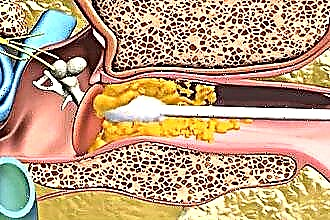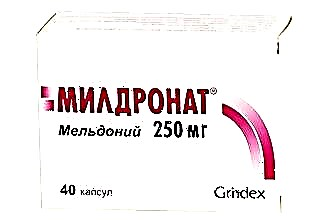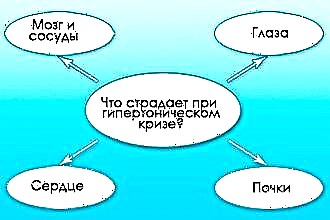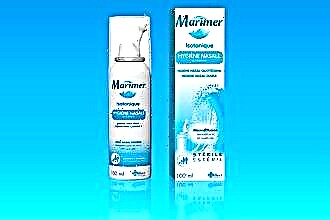Ear congestion after cleaning indicates non-compliance with the rules of the hygiene procedure. When using cotton swabs, metal objects and matches, there is a risk of mechanical damage to the eardrum and skin in the ear canal. Subsequently, inflammation occurs in the outer ear, which leads to a narrowing of the lumen in the ear canal and, accordingly, hearing impairment.
 If, after cleaning the ear with a cotton swab, the ear is blocked, you need to make sure that there are no perforations in the ear membrane. Damage to the membrane can be signaled by sharp and shooting pains in the ear, significant hearing loss and serous discharge. If unpleasant symptoms are found, you need to be examined by an otolaryngologist who, using an otoscope, will be able to determine the extent of damage in the ear canal and membrane.
If, after cleaning the ear with a cotton swab, the ear is blocked, you need to make sure that there are no perforations in the ear membrane. Damage to the membrane can be signaled by sharp and shooting pains in the ear, significant hearing loss and serous discharge. If unpleasant symptoms are found, you need to be examined by an otolaryngologist who, using an otoscope, will be able to determine the extent of damage in the ear canal and membrane.
About the outer ear device
The outer ear is represented by the tympanic membrane, the auricle and the auditory canal, which consists of two sections. The first section (membranous cartilaginous) is located closer to the auricle. It contains a large number of hairs, sebaceous and sulfur glands that produce sulfur and natural fat. In the bony section, located near the ear membrane, there are no hairs or glands, so the skin in it is more susceptible to injury.
According to experts, regular cleaning of earwax only helps to reduce local immunity. The liquid secret has pronounced antibacterial and antiseptic properties, which prevents the penetration of pathogens deep into the ear. Cleaning your ears changes the pH level in your ear canal, which increases the risk of pathogens entering the soft tissue.
The bony and membranous-cartilaginous sections are interconnected by a narrow isthmus. If the hygiene procedures are not carried out correctly, the sulfur masses are pushed into the ear, behind the isthmus, which subsequently leads to the formation of plugs. The plug creates a mechanical barrier in the path of sound signals, which contributes to hearing impairment and the appearance of a feeling of congestion.
As the epidermal cells grow, the sulfur masses are independently evacuated from the ear canal.
Causes of congestion
My ear is blocked after brushing, what should I do? First of all, you need to establish the root cause of the discomfort. Often, inept hygienic manipulations lead to tissue injury or the formation of dense plugs in the ear canal, as a result of which a feeling of congestion appears.
Discomfort can be provoked by:
- penetration of water deep into the ear;
- blockage of the ear canal with cotton;
- damage to the ear membrane;

- the formation of sulfur plugs;
- trauma to the skin in the ear canal.
It is not recommended to use cotton swabs to clean the ear canals. During their use, the likelihood of pushing sulfur into the bony part of the ear canal increases many times over.
Damage to the skin in the bone and cartilaginous parts of the outer ear contributes to a decrease in local immunity. This leads to the active reproduction of opportunistic microorganisms, the waste products of which provoke tissue inflammation. Edema of the auditory canal contributes to a decrease in the hearing threshold and a feeling of congestion.
Ear flushing by an ENT doctor
Regular cleansing of the ear canal from wax leads to its compaction and pushing behind the isthmus in the ear canal. This contributes to the formation of dense plugs, contributing to the complete blockage of the lumen in the ear canal. What to do if ear is blocked after brushing?
To relieve discomfort, you should seek help from an otolaryngologist. After a visual examination and assessment of the condition of the ear membrane, the doctor will suggest rinsing the congested ear. For this, Janet's syringe is often used with a portion of warmed up saline solution. The liquid is injected into the outer ear, after which the sulfur is easily removed from the ear canal.
After the procedure, a sterile cotton wool should be placed in the outer ear to prevent the penetration of pathogens.
For preschool children, ears are washed with Rivanol or Furacilin. The composition of the preparations includes components that contribute to the rapid softening of sulfur. Thus, it is possible to significantly reduce the duration of the entire procedure and eliminate the likelihood of damage to the auditory canal.
Self-removal of sulfur
I cleaned my ears and blocked my ear, what should I do? If the discomfort is provoked by a blockage of the ear canal with a sulfur plug, you can try to remove it yourself. To avoid complications, while performing hygienic manipulations, you need to follow a few simple rules:
- heat a 3% hydrogen peroxide solution to 37 degrees;
- moisten a cotton tourniquet in the solution and clean the ear from impurities;
- drip 2-3 drops of hydrogen peroxide into the sore ear;
- lay the auditory canal with a cotton swab for 5-6 minutes;
- dilute 1 tsp in 250 ml of warm water. potassium permanganate;
- draw a heated solution with potassium permanganate into a syringe;
- pour liquid into the ear to wash out the softened plug;
- Dry the ear canal with a cotton swab.
If the procedure is successful, the congestion completely disappears, and the surrounding sounds become louder and clearer.
Elimination of congestion
In some cases, even after removing the plug, ear congestion does not go away. What is the reason for this? A complete blockage in the ear canal reduces pressure in the outer ear, causing the eardrum to bulge out. Its stretching leads to disturbances in the conduct of sound signals due to the inability of the membrane to resonate the signals entering the ear.
You can relieve discomfort using the following techniques:
- close your mouth and, holding the wings of the nose with your hand, try to make an exit through the nose;
- with a closed nose, make 5-6 swallowing movements;
- Massage your temples to induce a deep yawn.

During swallowing and yawning, the mouth of the Eustachian tube opens, thereby leveling the pressure difference in the tympanic cavity and the outer ear. This contributes to the elimination of deformities in the ear membrane and, accordingly, the disappearance of the feeling of congestion.
When to see a doctor?
What should I do if I cleaned my ear and it is blocked? Hearing loss in some cases signals the occurrence of injuries in the ear canal or membrane. Swelling and inflammation of the tissues leads to a narrowing of the ear canal and impairment of hearing. Untimely elimination of pathogenic flora is fraught with the development of diffuse otitis media, myringitis, etc.
The indications for seeking help from an ENT doctor will be:
- ear pain;
- purulent discharge;
- tinnitus;
- hearing loss;
- swelling of the auricle;
- ear bleeding.
Important! The outer ear canal is 25 mm long. Cleaning with cotton swabs, matches, and metal pins can damage the membrane.
The above symptoms may indicate the occurrence of catarrhal processes not only in the outer, but also in the middle ear. With the transition of otitis media into a chronic form, otorrhea occurs, which does not allow the ear membrane to regenerate. This contributes to the development of persistent hearing loss, which can later be eliminated only with tympanoplasty.
Ear drops
What drops should I use if my ear is blocked after cleaning? It should be noted right away that topical preparations can be used to treat inflammatory processes only on the recommendation of a doctor. Some types of medicinal solutions contain components that have a local irritating effect. For this reason, they should not be buried in the ear canals if there are perforations in the ear membrane.
It is advisable to use ear drops when:
- the formation of sulfur plugs;
- development of otitis externa;

- damage to the skin in the ear canal;
- myringitis (inflammation of the membrane);
- otomycosis (fungal otitis externa);
- swelling of the external ear canal.
In order to eliminate pathogens and local manifestations of the disease in the framework of pharmacotherapy, drops of antibacterial, anti-inflammatory, wound healing, antifungal and antiviral effects are used.
Drug overview
If you cleaned your ear and it got blocked, what to do? With the formation of sulfur plugs, experts recommend using cerumenolytics. Preparations of this group contain surface active components that contribute to the softening of sulfur due to its hydration. After instilling a few drops of the solution into the ear canal, the plug dissolves on its own and flows out of the external auditory canal.
To eliminate inflammatory processes, the following types of ear drops can be used:
- Otipax is an analgesic and antiseptic drug that is used to treat otitis externa, middle and barotraumatic otitis media;
- "Otinum" - drops of disinfecting and antiphlogistic action, used to treat inflammatory processes in the outer and middle ear;
- "Garazon" is a glucocorticosteroid agent with a pronounced anti-inflammatory effect; used to treat bacterial inflammation in the skin and mucous membranes of the ENT organs.
Important! The course of treatment with ear drops should not exceed 10 days. Otherwise, morphological changes in the structure of soft tissues are possible.






